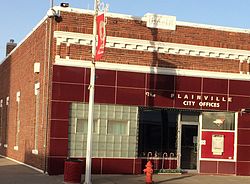Plainville, Kansas
| Plainville, Kansas | |
|---|---|
| City | |

Plainville City Offices (2016)
|
|
 Location within Rooks County and Kansas |
|
 KDOT map of Rooks County (legend) |
|
| Coordinates: 39°13′56″N 99°18′11″W / 39.23222°N 99.30306°WCoordinates: 39°13′56″N 99°18′11″W / 39.23222°N 99.30306°W | |
| Country | United States |
| State | Kansas |
| County | Rooks |
| Incorporated | 1888 |
| Area | |
| • Total | 1.24 sq mi (3.21 km2) |
| • Land | 1.24 sq mi (3.21 km2) |
| • Water | 0 sq mi (0 km2) |
| Elevation | 2,146 ft (654 m) |
| Population (2010) | |
| • Total | 1,903 |
| • Estimate (2015) | 1,895 |
| • Density | 1,500/sq mi (590/km2) |
| Time zone | CST (UTC-6) |
| • Summer (DST) | CDT (UTC-5) |
| ZIP code | 67663 |
| Area code | 785 |
| FIPS code | 20-56150 |
| GNIS feature ID | 0472441 |
| Website | PlainvilleKS |
Plainville is a city in Rooks County, Kansas, United States. As of the 2010 census, the city population was 1,903. It was named from its setting upon the plains.
Washington Irving Griffin settled along a freight trail in an area known as Paradise Flats in 1877. In order to establish a post office, Griffin completed a US Postal Service application that required the signature of the local Justice of the Peace. While reviewing the application, Justice of the Peace Lambert P. Darland suggested the name “Plainville”. Griffin operated the Plainville post office and a small store from his sod house, the first structure in what would become the city of Plainville.
In 1888, Plainville filed for incorporation with 500 residents. Dan E. Miller was elected the first mayor. The first city council consisted of Dr. Volney M. Gray, Murray C. Knox, John Mullin, George Brooks and David E. Mickey.
Union Pacific Railroad established an east-west route through Plainville in August 1888. The train tracks ran parallel to Mill Street, approximately one block to the north. The Train Depot was located on the northwest corner of N First Street and Meridian Street. A Roundhouse was located at N First Street and Madison Street.
Plainville Mill & Elevator Co., (est. 1893) was a major employer and purchaser of locally grown wheat. The original mill was destroyed by fire in 1899 and soon replaced by a larger mill. The flour produced by the mill was of such fine quality, the company won a gold medal at the 1904 World’s Fair. The mill was again destroyed by fire in 1950. Plainville Mill & Elevator Co. was located on N First Street between Madison and Meridian Streets.
In 1909, fire devastated the Plainville business district. The fire apparently started in a butcher shop on the south side of Mill Street in the early morning hours. Fire quickly spread to the north side of Mill Street. Seventeen structures were destroyed before the fire was contained. The burned out wooden buildings were replaced with stone and brick structures, many still standing on Mill Street today.
...
Wikipedia
